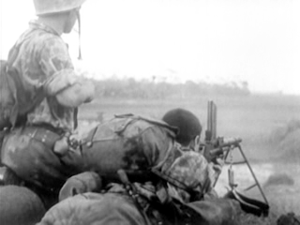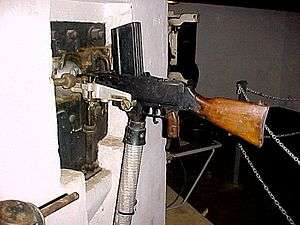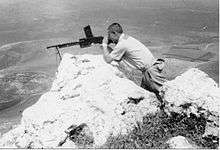FM 24/29 light machine gun
The Fusil-mitrailleur Modèle 1924 M29 was the standard light machine gun of the French Army from 1925 until the 1960s and was in use until 2000-2006 with the National Gendarmerie. It fires the French 7.5×54mm round which is equivalent in ballistics and striking power to the later 7.62×51mm NATO (.308 Winchester) and 7.62×54mmR round. A robust and reliable weapon partly derived from the M1918 Browning Automatic Rifle (BAR) action, the FM 1924 M29 soldiered on, practically without interruptions, for more than 50 years.
| FM 24/29 | |
|---|---|
LMG 24/29 | |
| Type | Light machine gun |
| Place of origin | France |
| Service history | |
| In service | 1925-1979 (French Army) 1956-2008 (Gendarmerie nationale) |
| Used by | See Users |
| Wars | Rif War World War II First Indochina War Algerian War Suez Crisis 1958 Lebanon crisis Vietnam War Cambodian Civil War Laotian Civil War Lebanese Civil War |
| Production history | |
| Designer | Lt col. Reibel assisted by Chief Armorer Chosse |
| Designed | 1920-1924 |
| Manufacturer | Manufacture d'Armes de Châtellerault |
| Unit cost | ? |
| Produced | 1925-1960s (232,942 units) |
| Variants | M1924-M29D M1931 |
| Specifications | |
| Mass | 8.9 kg (19.7 lb) |
| Length | 1080 mm (42.5 in) |
| Barrel length | 500 mm (19.5 in) |
| Cartridge | 7.5×54mm French |
| Caliber | 7.5mm |
| Barrels | 1 |
| Action | Gas-operated Bolt-link |
| Rate of fire | 450 rpm |
| Muzzle velocity | 830 m/s (2,722.4 ft/s) |
| Effective firing range | 1250 m (3,937 ft) |
| Maximum firing range | 3950 m (12,959 ft) |
| Feed system | 25 round detachable box magazine |
| Sights | Iron sights |
Development
After the end of World War I, the French Army sought to replace the problematic Fusil-mitrailleur mle 1915 CSRG light machine rifle (better known as the Chauchat). French commanders considered standardizing on the American Browning Automatic Rifle (BAR), but eventually required the development of a locally built weapon. MAS (an abbreviation of Manufacture d'Armes de St. Etienne - one of several government-owned arms factories in France) proposed a direct derivative of the BAR, but the Manufacture d'Armes de Châtellerault (MAC) won the bid with its weapon, which was partly derived from the BAR action. It had been formulated and designed by a Lieutenant Colonel Reibel assisted by Chief Armorer Chosse.
The FM Mle 1924 entered production in late July 1925 and saw first operational use in Morocco in May 1926. It was immediately well-received and even favorably compared in performance with the much heavier Hotchkiss machine gun. However, problems created by the new 7.5mm ammunition did appear. In particular, 8×57mm Mauser ammunition which was used in captured Mauser rifles carried by auxiliaries in Morocco during the Rif War from 1920–26, could be chambered and fired with disastrous results. This situation led to the development of a slightly shorter 7.5×54mm round, which was retained in 1929 as the standard ammunition for all future rifles and light machine guns in French service. The modified fusil-mitrailleur modèle 1924 modifié 1929 (FM Mle 1924 M29) was mass-manufactured (187,412), beginning in 1930. In addition to these newly manufactured guns some 45,530 older FM Mle 1924s, already in service after phasing out the notoriously unreliable Chauchat, were rebarreled in order to accept the newer 7.5×54mm ammunition.
Both the original fusil-mitrailleur Mle 1924 (automatic rifle, model of 1924) as well as the modified Mle 1924 M29 have the same overall features: a folding bipod, an in-line stock, a pistol grip, a top-mounted 25-round detachable magazine and a bolt hold-open after the magazine's last round had been fired. There are two separate triggers: the trigger in front for using semi-automatic fire only and the rear trigger for firing on full automatic. Protection of all the openings against mud and dust proved excellent. The cyclic rate was controlled at 450 rounds per minute, thus allowing more continuous firing without overheating. In general, this new weapon was accurate and highly reliable but the barrel was screwed well into the receiver, as in the Browning Automatic Rifle (BAR), and thus it could not be separated quickly and easily in the field as for the British Bren gun. The French Army instruction manual (July 1925) recommends not to go beyond 400 rounds of uninterrupted firing since at that point the gun needs to be given a pause of ten to fifteen minutes in order to cool off. But instead, the French instruction manual recommends the following routine for the FM 1924 : fire 4 to 5 detachable magazines (100 to 125 rounds), take a short pause, then keep repeating that same restrained fire plus short pause routine which permits steady performance and very extensive firing periods.
Operational use

The FM 24/29 was the standard squad-level automatic weapon of the French infantry and cavalry at the start of World War II. After the French surrender in World War II, the Germans captured large quantities of this weapon, which they used operationally until the end of the war.
From 1943 on, as the French army was re-equipped and reorganized in North Africa with Allied support, the FM 24/29 was kept in service, as French troops considered it superior to the Browning Automatic Rifle.
The FM 24/29 was the workhorse in the First Indochina War and served in the armed forces until after the end of the war in Algeria.[1] It was replaced by the AA-52 general-purpose machine gun in the 1960s, but it was still in use with National Gendarmerie regional brigades until 2000-2006.
Variants
Model 1924/1929D machine gun

The Model 1924/1929D machine gun was a variant of the MAC 24/29, adapted to firing from interior firing ports in the bunkers of the Maginot Line.[2]
M1931
A derivative of the gun, the MAC Modèle 1931, with a heavier barrel and 150-round side-mounted pan magazine, was produced as a heavy machine gun for installation in tanks and fortified emplacements, particularly the Maginot Line.
Users











.svg.png)

.svg.png)

.svg.png)

See also
References
- "L'armement français en A.F.N." Gazette des Armes (in French). No. 220. March 1992. pp. 12–16.
- http://armesfrancaises.free.fr/FM%20Mle%2024-29%20(D).html
- Windrow, Martin (1997). The Algerian War, 1954-62. Men-at Arms 312. London: Osprey Publishing. p. 22. ISBN 978-1-85532-658-3.
- Gander, Terry J.; Cutshaw, Charles Q., eds. (2001). Jane's Infantry Weapons 2001/2002 (27th ed.). Coulsdon: Jane's Information Group. ISBN 9780710623171.
- "World Infantry Weapons: Djibouti". 2007–2015. Archived from the original on 24 November 2016. Retrieved 21 November 2018.
- Jowett, Philip; Snodgrass, Brent (5 Jul 2006). Finland at War 1939–45. Elite 141. Osprey Publishing. p. 50. ISBN 9781841769691.
- http://world.guns.ru/machine/fr/mac-m1924-e.html
- armesfrancaises.free.fr/FM Mle 24-29.html
- Conboy, Kenneth (23 Nov 1989). The War in Laos 1960–75. Men-at-Arms 217. Osprey Publishing. p. 15. ISBN 9780850459388.
- Chris Bishop (2002). The Encyclopedia of Weapons of World War II. Sterling Publishing Company, Inc. p. 241. ISBN 978-1-58663-762-0.
- Peter Chamberlain; Terry Gander (1974). Machine guns. Arco Pub. Co. p. 15. ISBN 978-0-668-03608-5.
- "World Infantry Weapons: Niger". 2007–2014. Archived from the original on 24 November 2016.
- Windrow, Martin (15 Nov 1998). The French Indochina War 1946–54. Men-at-Arms 322. Osprey Publishing. p. 24. ISBN 9781855327894.CS1 maint: ref=harv (link)
- Chris Bishop (1996). Vital Guide to Combat Guns and Infantry Weapons. p. 203. ISBN 1853105392.
- "Những vũ khí viện trợ đã ra trận cùng QĐVN trong trận Điện Biên Phủ". tintuc.vn (in Vietnamese). 11 November 2014.
- Gordon L. Rottman (2010). Army of the Republic of Vietnam 1955–75. Men-at-Arms 458. Osprey Publishing. p. 43. ISBN 9781849081818.
Bibliography
- Ferrard, Stéphane. France 1940 l'armement terrestre, ETAI, 1998, ISBN 978-2-7268-8380-8
- Philippe Truttman, La Muraille de France ou la Ligne Maginot, Gérard Klopp éditeur, 1985.
- Claude Lombard, La Manufacture Nationale d'Armes de Chatellerault, 1987, Editor : Brissaud,162 Grande Rue, Chatellerault. A technical history of all the military firearms developed and manufactured at Chatellerault . This volume includes a highly detailed technical chapter dealing with the FM Mle 1924 and Mle 1924-M29. ISBN 2-902170-55-6 ( in French ).
- "Instruction Provisoire de Juillet 1925 sur le Fusil-Mitrailleur 1924", Charles-Lavauzelle & Cie, Paris, 1928.